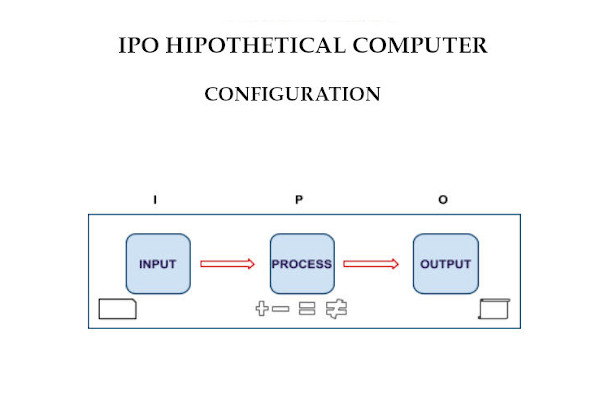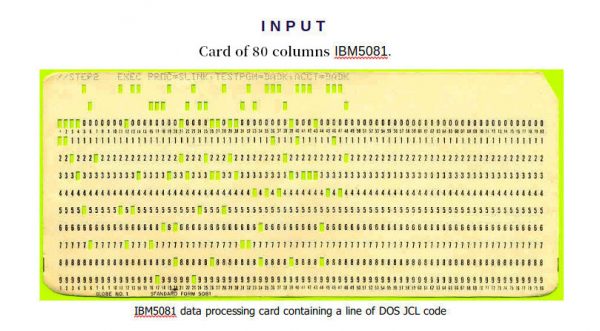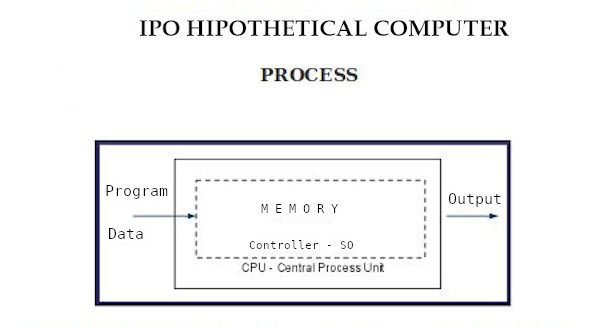

Note: In the 1960s / 70’s cards of 80 and 96 columns were widely used by IBM/360 and IBM / 3A systems reading of the perforated cards is performed by the Punch card reader.
This IBM card format, designed in 1928, had rectangular holes, in an 80-line matrix with 10 lines, plus two called zones. The ten positions (from top to bottom) represent the digits 0 to 9.
The first two positions of a column were called zone, 12 (top) and 11. The combination of perforations in a column, corresponds to an 8-bit character encoding (1 byte) called EBCDIC encoding On the above card note that the number 2 that appears printed in blue at the top of the card in column 5, corresponds to a single drilling at the time of the Line 2.
Note: After reading the card, the byte (position) of the memory corresponding to the decimal number 2 has the following binary representation in a 8-bit byte: 1111 0010 ( EBCDIC) On the above card note that the number 2 that appears printed in blue at the top of the card in column 5, corresponds to a single drilling at the time of the Line 2.
Note: After reading the card, the byte (position) of the memory corresponding to the decimal number 2 has the following binary representation in a 8-bit byte: 1111 0010 (EBCDIC)
To better understand EBCDIC encoding, note that the letter to which appears printed at the top of the card, corresponds to the perforations in lines 1 and zone 12 of the column.
Note: After reading the card, the byte (position) of the memory corresponding to the letter A has the following binary representation: 1100 0001 that in the memory Dump will appear as hexadecimal C1 See Tabel DEC – HEX – ASCii- EBCDIC.
See More: Computer data storage
Recommended reading: Punched Cards

Processing is carried out by the Central Process Unit of the IPO, which is divided into 2 parts: a) memory to store up to 1000 characters; b) a set (set) of 8 instrutions.
As a all computer, the IPO operates with binary data.
know more about bit e bytes Understand binary, decimal and hexadecimal convertion, See Table DEC – HEX – ASCii – EBCDIC
HIPOTHETICAL COMPUTER
OUTPUT
The output (output) is performed by a line printer similar to IBM 1403 Recommended Topics: Data Processing and Hypothetical Machine
Control
The controller of the central processing unit of the IPO has two buttons.
When pressed it start the following processes:1. BOOT – Stores the program into IPO memory
AIt triggers the card reader that “reads” the cards until you find “/ *” in columns 1-2;
– constants (C na col 4) and instruções (Up to 11 bytes) contained from column 5, are stored at memory address specified in the 1-3 columns of the cards;
Note: The files on cards were delimited by “/* and/or “/&”

ABSTRACT
-
Input – Hollerich Card – Reader Cards (80 columns)
-
1.1 Charge from the cards with the instructions (program) that are stored
In Memory of the IPO (Boot button); After the load the process only starts when pressed the START button
-
1.2 Data cards (optional) are read with the Read statement (see below).
2. Process
-
2.1. CPU containing a set of 8 instructions
-
2.2. Memory with a total capacity of 1000 posts (letters, numbers and special characters. The addressing goes from 000 to 999.
3. Output
-
The IPO printer prints a line of up to 99 characters with the execution of the Write instruction.
Go to INSTRUCTIONS SET
